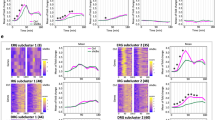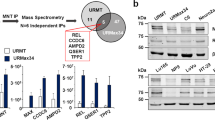Abstract
RelA and RelB are two members of the NF-κB family that differ structurally and functionally. While RelA is regulated through its cytosolic localization by inhibitor proteins or IκB and not through transcriptional mechanisms, the regulation of RelB is poorly understood. In this study we demonstrate that stimuli (TNF or LPS) lead within minutes to the nuclear translocation of RelA, but require hours to result in the nuclear translocation of RelB. The delayed nuclear translocation of RelB correlates with increases in its protein synthesis which are secondary to increases in RelB gene transcription. RelA is alone sufficient to induce RelB gene transcription and to mediate the stimuli-driven increase in RelB transcription. Cloning and characterization of the RelB 5′ untranslated gene region indicates that RelB transcription is dependent on a TATA-less promoter containing two NF-κB binding sites. One of the NF-κB sites is primarily involved in the binding of p50 while the other one in the binding and transactivation by RelA and also RelB. Lastly, it is observed that p21, a protein involved in cell cycle control and oncogenesis known to be regulated by NF-κB, is upregulated at the transcriptional level by RelB. Thus, RelB is regulated at least at the level of transcription in a RelA and RelB dependent manner and may exert an important role in p21 regulation.
This is a preview of subscription content, access via your institution
Access options
Subscribe to this journal
Receive 50 print issues and online access
$259.00 per year
only $5.18 per issue
Buy this article
- Purchase on Springer Link
- Instant access to full article PDF
Prices may be subject to local taxes which are calculated during checkout









Similar content being viewed by others
References
Ammon C, Mondal K, Andreesen R, Krause SW . 2000 Biochem. Biophys. Res. Commun. 268: 99–105
Asada M, Yamada T, Ichijo H, Delia D, Miyazono K, Fukumuro K, Mizutani S . 1999 EMBO J. 18: 1223–1234
Asin S, Taylor JA, Trushin S, Bren G, Paya CV . 1999 J. Virol. 73: 3893–3903
Beg AA, Baltimore D . 1996 Science 274: 782–784
Beg AA, Sha WC, Bronson RT, Ghosh S, Baltimore D . 1995 Nature (London) 376: 167–170
Burkly L, Hession C, Ogata L, Reilly C, Marconi LA, Olson D, Tizard R, Cate R, Lo D . 1995 Nature (London) 373: 531–536
Carrasco D, Ryseck R-P, Bravo R . 1993 Development 118: 1221–1231
Dignam JD, Lebovitz RM, Roeder RG . 1983 Nucleic Acids Res. 11: 1475–1489
Dobrzanski P, Ryseck R-P, Bravo R . 1993 Mol. Cell. Biol. 13: 1572–1582
Dobrzanski P, Ryseck R-P, Bravo R . 1994 EMBO J. 13: 4608–4616
Dotto GP . 2000 Biochim. Biophys. Acta. 1471: M43–M56
Ferreira V, Tarantino N, Korner M . 1998 L. Biol. Chem. 273: 592–599
Francis DA, Sen R, Rice N, Rothstein T . 1998 Int. Immunology. 10: 285–293
Hannink M, Temin HM . 1990 Oncogene 5: 1843–1850
Ivanov VN, Deng G, Podack ER, Malek TR . 1995 Int. Immunol. 7: 1709–1720
Javelaud D, Wietzerbin J, Delattre O, Besancon F . 2000 Oncogene 19: 61–68
Jiang Y, Porter AG . 1998 Biochem. Biophys. Res. Commun. 245: 691–697
Kistler B, Rolink A, Marienfeld R, Neumann M, Wirth T . 1998 J. Immunol. 160: 2308–2317
Le Bail O, Schmidt-Ullrich R, Israel A . 1993 EMBO J. 12: 5043–5049
Lernbecher T, Kistler B, Wirth T . 1994 EMBO J. 13: 4060–4069
Lernbecher T, Muller U, Wirth T . 1993 Nature (London) 365: 767–770
Liou HC, Sha WC, Scott ML, Baltimore D . 1994 Mol. Cell Biol. 14: 5349–5359
Liptay S, Schmid RM, Nabel EG, Nabel GJ . 1994 Mol. Cell Biol. 14: 7695–7703
McElhinny JA, MacMorran WS, Bren GD, Ten RM, Israel A, Paya CV . 1995 J. Virol. 69: 1500–1509
Menetski JP . 2000 J. Biol. Chem. 275: 7619–7625
Neumann M, Wohlleben G, Chuvpilo S, Kistler B, Wirth T, Serfling E, Schimpl A . 1996 J. Immunol. 157: 4862–4869
Neumann M, Fries H, Scheicher C, Keikavoussi P, Kolb-Maurer A, Brocker E, Serfling E, Kampgen E . 2000 Blood 95: 277–285
Olashaw NE . 1996 J. Biol. Chem. 271: 30307–30310
Pennington KN, Taylor JA, Bren GD, Paya CV . 2001 Mol. Cell Biol. 21: 1930–1941
Pettit AR, Quinn C, MacDonald KPA, Cavanagh LL, Thomas G, Townsend W, Handel M, Thomas R . 1997 J. Immunol. 159: 3681–3691
Ruben SM, Klement JF, Coleman TA, Maher M, Chen C-H, Rosen C . 1992 Genes Dev. 6: 745–760
Ryseck R-P, Bull P, Takamiya M, Bours V, Siebenlist U, Dobrzanski P, Bravo R . 1992 Mol. Cell Biol. 12: 674–684
Suhasini M, Pilz RB . 1999 Oncogene 18: 7360–7369
Suhasini M, Reddy CD, Reddy EP, DiDonato JA, Pilz RB . 1997 Oncogene 15: 1859–1870
Ten RM, Paya CV, Israel N, Le Bail O, Mattei MG, Virelizier JL, Kourilsky P, Israel A . 1992 EMBO J. 11: 195–203
Wang CY, Cusack Jr JC, Liu R, Baldwin Jr AS . 1999 Nat. Med. 5: 412–417
Weih F, Carrasco D, Bravo R . 1994 Oncogene 9: 3289–3297
Weih F, Carrasco D, Durham SK, Barton DS, Rizzo CA, Ryseck R-P, Lira SA, Bravo R . 1995 Cell 80: 331–340
Weih F, Lira SA, Bravo R . 1996a Oncogene 12: 445–449
Weih F, Durham SK, Barton DS, Shaw WC, Baltimore D, Bravo R . 1996b J. Immunol. 157: 3974–3979
Acknowledgements
The work in this manuscript was supported by NIH grant R01 #AI36076. The authors would like to thank Dr Amer Beg from Columbia University for providing us with the Rel+/− and Rel−/− MEF, Dr Nancy Rice of NCI-Frederick Cancer Research Center for the RelB antibody, Dr Wafik El-Deiry from the University of Pennsylvania for the p21 promoter construct, the members of Dr Paya's laboratory for the helpful discussions, and Teresa Hoff for assistance in preparing this manuscript.
Author information
Authors and Affiliations
Corresponding author
Rights and permissions
About this article
Cite this article
Bren, G., Solan, N., Miyoshi, H. et al. Transcription of the RelB gene is regulated by NF-κB. Oncogene 20, 7722–7733 (2001). https://doi.org/10.1038/sj.onc.1204868
Received:
Revised:
Accepted:
Published:
Issue Date:
DOI: https://doi.org/10.1038/sj.onc.1204868
Keywords
This article is cited by
-
A20 undermines alternative NF-κB activity and expression of anti-apoptotic genes in Helicobacter pylori infection
Cellular and Molecular Life Sciences (2022)
-
Fusion transcripts FYN-TRAF3IP2 and KHDRBS1-LCK hijack T cell receptor signaling in peripheral T-cell lymphoma, not otherwise specified
Nature Communications (2021)
-
Role of NF-kappaB2-p100 in regulatory T cell homeostasis and activation
Scientific Reports (2019)
-
Classical and alternative NF-κB signaling cooperate in regulating adipocyte differentiation and function
International Journal of Obesity (2016)
-
Potent and Targeted Activation of Latent HIV-1 Using the CRISPR/dCas9 Activator Complex
Molecular Therapy (2016)



